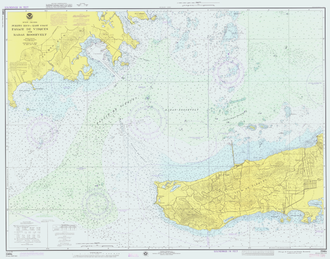Nautical chart
A nautical chart is a graphic representation of a maritime area and adjacent coastal regions. Depending on the scale of the chart, it may show depths of water and heights of land, natural features of the seabed, details of the coastline, navigational hazards, locations of natural and man-made aids to navigation, information on tides and currents, and local details of the Earth's magnetic field.
History
The history of nautical charts dates back to ancient times when mariners used rudimentary maps to navigate the seas. The development of more accurate charts began in the Age of Exploration, with significant contributions from explorers such as Christopher Columbus and James Cook. The advent of modern cartography and the use of advanced surveying techniques have greatly improved the accuracy and detail of nautical charts.
Components
Nautical charts contain several key components:
- Scale: Indicates the relationship between a distance on the chart and the actual distance on the ground or water.
- Latitude and Longitude: Coordinate system used to define the position of a point on the Earth's surface.
- Depths: Shown in meters or feet, indicating the depth of water at various points.
- Navigational hazards: Features such as rocks, reefs, and shipwrecks that pose a danger to navigation.
- Aids to navigation: Includes lighthouses, buoys, and beacons that assist mariners in determining their position and course.
Types of Nautical Charts
There are several types of nautical charts, each serving a specific purpose:
- General charts: Used for planning long voyages and for offshore navigation.
- Coastal charts: Used for navigation in coastal waters.
- Harbor charts: Detailed charts used for navigation in harbors and small waterways.
- Special purpose charts: Designed for specific needs, such as fishing or military operations.
Usage
Nautical charts are essential tools for navigation. Mariners use them to plot courses, avoid hazards, and ensure safe passage. They are also used in conjunction with other navigational tools such as compasses, sextants, and GPS devices.
Maintenance and Updates
Nautical charts must be regularly updated to reflect changes in the maritime environment. This includes new hazards, changes in water depths, and updates to aids to navigation. Organizations such as the National Oceanic and Atmospheric Administration (NOAA) and the United Kingdom Hydrographic Office (UKHO) are responsible for producing and updating nautical charts.
Related Pages
- Navigation
- Compass
- Sextant
- Global Positioning System
- Latitude
- Longitude
- Tide
- Current (water)
- Hydrography
Categories
| Navigation topics | ||||||||
|---|---|---|---|---|---|---|---|---|
This navigation-related article is a stub.
|
Transform your life with W8MD's budget GLP-1 injections from $125.
W8MD offers a medical weight loss program to lose weight in Philadelphia. Our physician-supervised medical weight loss provides:
- Most insurances accepted or discounted self-pay rates. We will obtain insurance prior authorizations if needed.
- Generic GLP1 weight loss injections from $125 for the starting dose.
- Also offer prescription weight loss medications including Phentermine, Qsymia, Diethylpropion, Contrave etc.
NYC weight loss doctor appointments
Start your NYC weight loss journey today at our NYC medical weight loss and Philadelphia medical weight loss clinics.
- Call 718-946-5500 to lose weight in NYC or for medical weight loss in Philadelphia 215-676-2334.
- Tags:NYC medical weight loss, Philadelphia lose weight Zepbound NYC, Budget GLP1 weight loss injections, Wegovy Philadelphia, Wegovy NYC, Philadelphia medical weight loss, Brookly weight loss and Wegovy NYC
|
WikiMD's Wellness Encyclopedia |
| Let Food Be Thy Medicine Medicine Thy Food - Hippocrates |
Medical Disclaimer: WikiMD is not a substitute for professional medical advice. The information on WikiMD is provided as an information resource only, may be incorrect, outdated or misleading, and is not to be used or relied on for any diagnostic or treatment purposes. Please consult your health care provider before making any healthcare decisions or for guidance about a specific medical condition. WikiMD expressly disclaims responsibility, and shall have no liability, for any damages, loss, injury, or liability whatsoever suffered as a result of your reliance on the information contained in this site. By visiting this site you agree to the foregoing terms and conditions, which may from time to time be changed or supplemented by WikiMD. If you do not agree to the foregoing terms and conditions, you should not enter or use this site. See full disclaimer.
Credits:Most images are courtesy of Wikimedia commons, and templates, categories Wikipedia, licensed under CC BY SA or similar.
Contributors: Prab R. Tumpati, MD







